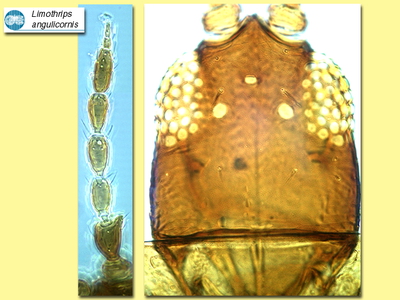Figures
Fig. 1 Antenna and head
Fig. 2 Fore and hind wing
Fig. 3 Tergites VII-X (female)
Species
Limothrips angulicornis Jablonowski
Biology
Living in the florets and leaf sheaths of grasses and cereals, but with no evidence for host specificity.
Distribution
Southern Europe including Spain and Italy; also recorded from Chile,California and southern Australia.
Recognition
Body and legs dark brown, tarsi and antennal segment III paler; forewings light brown; major setae at apex of abdomen dark brown. Head longer than wide, prolonged in front of eyes, without long setae. Antennae 8-segmented, II with distal external margin produced into a tooth; III & IV with sense cone forked; VIII longer than VII. Pronotum with one pair of prominent slender posteroangular setae. Metanotal median setae small and arising behind anterior margin. Forewing slender, first vein with 3 setae widely spaced on distal half, second vein with about 8 equally spaced setae. Abdominal tergites with median pores situated close to posterior margin; VIII without a marginal comb but with one pair of stout setae laterally; IX with one pair of thorn-like setae laterally; X with one pair of stout thorn-like setae near apex. Male apterous, head without ocelli; tergite IX with median pair of setae very short and stout; sternites without glandular areas.
Related species
From the other four species in the genus, all originally from Europe, this species is distinguished by the lateral prolongation of the second antennal segment.




